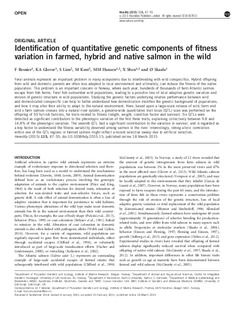| dc.description.abstract | Feral animals represent an important problem in many ecosystems due to interbreeding with wild conspecifics. Hybrid offspring from wild and domestic parents are often less adapted to local environment and ultimately, can reduce the fitness of the native population. This problem is an important concern in Norway, where each year, hundreds of thousands of farm Atlantic salmon escape from fish farms. Feral fish outnumber wild populations, leading to a possible loss of local adaptive genetic variation and erosion of genetic structure in wild populations. Studying the genetic factors underlying relative performance between wild and domesticated conspecific can help to better understand how domestication modifies the genetic background of populations, and how it may alter their ability to adapt to the natural environment. Here, based upon a large-scale release of wild, farm and wild x farm salmon crosses into a natural river system, a genome-wide quantitative trait locus (QTL) scan was performed on the offspring of 50 full-sib families, for traits related to fitness (length, weight, condition factor and survival). Six QTLs were detected as significant contributors to the phenotypic variation of the first three traits, explaining collectively between 9.8 and 14.8% of the phenotypic variation. The seventh QTL had a significant contribution to the variation in survival, and is regarded as a key factor to understand the fitness variability observed among salmon in the river. Interestingly, strong allelic correlation within one of the QTL regions in farmed salmon might reflect a recent selective sweep due to artificial selection. | nb_NO |

